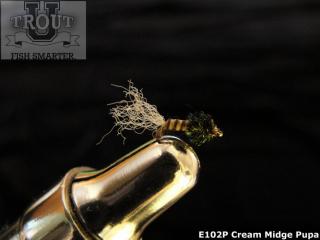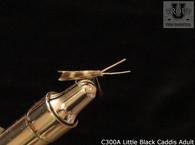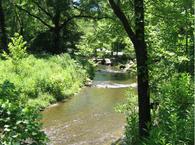
Midges are not used enough by fly fishermen and it may be due to their small size, or to a lack of confidence, or even to a lack of knowledge. In this class, the angler will learn how to recognize the hatch and how trout respond to the hatch. The student will also learn how to fish the imitations of the life stages of the midges.
The importance of Chironomidae commonly called midges is often overlooked. Midges are very small two winged flies that resemble mosquitoes. Their lives start with eggs deposited by adults after they have mated. Some of the species are free-swimming larvae including the bloodworm and glassworm. These larvae develop into the pupae stage of life and emerge by swimming to the surface of the water where they hatch into full grown adults. Midges normally hatch periodically all year around and are available as food for trout in the larvae, pupae or adult stages throughout the year.
It has been said that midges represent about one-half of all the aquatic insects living in streams and lakes combined. It doesn’t matter whether the bottom is muddy, rocky, or sandy. Midge of one species or another can survive as long as algae exist for them to feed on.
Despite the fact that midges are readily eaten by trout throughout the entire year in all the trout streams and lakes in the United States, most fly fishermen include only a few midge patterns in their fly boxes. The reason for this lack of respect for the midges is that anglers have had little experience with them and they do not have confidence in them as well. Why would a trout want to spend energy eating such a tiny morsel of food, and why would any angler want to fish with such a small fly? The anglers may be thinking, "after all, a larger fly is easier to see, and would be much more appealing to fish, especially the larger browns".
Midges are so small down to size 26, that most of us have a very difficult time tying them on our tippet. This fact led to the creation of “midge threader” fly boxes that have been designed to aid the anglers.
Hatch Times:
Midge hatches have no rhyme nor reason, they can hatch anytime of the day from early in the morning to late in the evening and it seems that it is never when you expect it. Snow, wind, rain or heat have little effect on the hatch times which range from the hottest day in July to the coldest day in January. It appears that like other aquatic insects, midge emergence is greatest during periods of low atmospheric pressure, or cloudy, overcast days however, you may indeed find midges hatching on the brightest days of the year.
Fishing Dry Flies:
In slow moving water, midges will often be drifting in the surface film in scum lines or current seams where you will see the presence of bubbles. You may not be able to see the emerging midge pupae but your only clues are the slight bulges made by a trout sipping the pupae. Get as close as you can to the trout rising to sip a pupae and present your fly just in front of the trout realizing that he will not expend a great deal of energy for such a small morsel. The trout are usually holding just under the surface of the water and their area of vision where they can spot drifting midges is very small. You will need a good dead drift to avoid spooking the trout.
Start with at a 10 or 12 foot long leader and use 6 or 7X tippets. Slow action rods are generally preferred over fast action rods. The added flex of a slow action rod will cushion the shock when you set the hook, saving the light tippet. Since it is difficult to see the real adult midge or your imitation midge on the water, locating your fly on the water takes some practice. Cast far above where you suspect the trout are and when your fly is approaching the target area; give the fly a slight tug creating a slight v wake. This will allow you to pinpoint the location of your fly. Be sure that your alignment is correct, ensuring that the fly will be in line to drift directly over the trout. Remember to take in the refraction of light by reviewing Class 206 What Can Trout See.
Fishing Pupa Imitations:
On many occasions, there will be more than one midge hatch occurring simultaneously and you must be able to determine the size, the color and the stage of a hatch to be most successful. The pupae are quite different in color from the larvae and the adults as well. Fly fishing with the pupa imitation usually brings the most success with midges. When the pupae are suspended in the surface film trying to hatch, they are extremely vulnerable to the trout and the trout will be focused on them. When trout begin to feed on the emerging midge pupae, you will usually just see the fins of the fish break surface of the water.
To rig the fly, start with 9 feet of 5X tippet, use a surgeon knot to add about 12 or more inches of 6X tippet, and then tie on a midge pattern attractor fly to the end of the added tippet. Use an improved clinch knot to add another 18 inches of 6 X or 7X tippet to the bend of the hook in the attractor fly. Then add the midge pupa. Cast this rig without weight for the trout feeding on the emergers.
To use this rig for fly fishing with the larva imitation, Add weight by placing it on the leader just above the first knot you tied when you added the extra tippet. This knot will prevent the weight from sliding down the leader. If you choose to use a strike indicator, attach it 1 ½ times the depth of the water from the bottom fly.
When you see fish rising but do not see any flies in the air, consider fishing a midge pupa fly in conjunction with a mayfly emerger or caddis pupa. Sometimes the trout will favor the midge emerger and ignore the mayfly or caddis flies.
Fishing Midge Larva Imitations:
Midge larva patterns are generally effective early in the mornings and between hatches. The imitation larva fly should be worked at or near the bottom of the stream. Consider fishing a midge larva fly in conjunction with a mayfly nymph or caddis larva. Rig the midge larva a few inches below the mayfly nymph or caddis larva and the added weight of the nymph or caddis larva will help in getting the midge larva down near or on the bottom. Depending on the speed and the depth of the water, it may be necessary to add weight above the top fly.
Read the TroutU.com blog entitled "Midges are a Staple in the Diet of Trout". You can find this by clicking on blogs or you can search the site with the word midges.
For extra credit, please examine the "Perfect Fly" midge flies that are available in the TroutU shop. Take notice of the detail in these flies.





